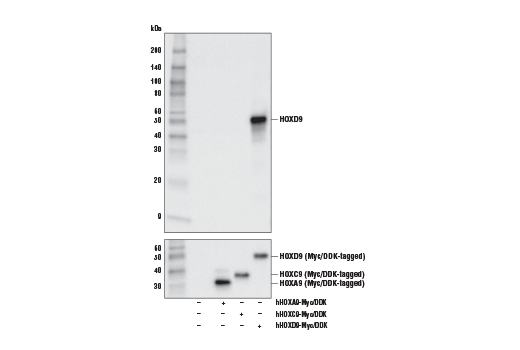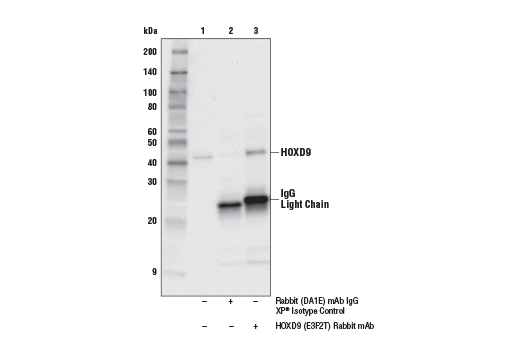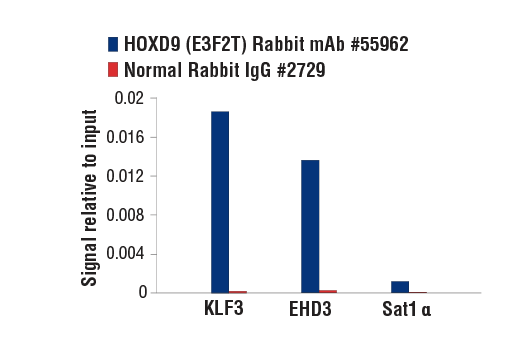WB, IP, ChIP
H Mk
Endogenous
42
Rabbit IgG
#P28356
3235
Product Information
Product Usage Information
For optimal ChIP results, use 10 μl of antibody and 10 μg of chromatin (approximately 4 × 10^6 cells) per IP. This antibody has been validated using SimpleChIP® Enzymatic Chromatin IP Kits.
| Application | Dilution |
|---|---|
| Western Blotting | 1:1000 |
| Immunoprecipitation | 1:50 |
| Chromatin IP | 1:50 |
Storage
Specificity / Sensitivity
Species Reactivity:
Human, Monkey
Source / Purification
Monoclonal antibody is produced by immunizing animals with a synthetic peptide corresponding to residues surrounding Gly159 of human HOXD9 protein.
Background
Homeobox protein Hox-D9 (HOXD9) is a sequence-specific transcription factor that is part of a developmental regulatory program that provides cells with specific positional identities on the anterior-posterior axis. HOXD9 is developmentally expressed in structures of either mesodermal or neuro-ectodermal origin, such as developing limbs, gonads, and the central nervous system (1-6). HOXD9 plays a critical role in regulation of limb development, neuronal development, and development of mammary glands and gonads in many organisms (1-6). The HOXD9 gene promoter is found to be hypermethylated and silenced in multiple types of cancer, including breast cancer, melanoma brain metastases, and cholangiocarcinomas (7-9). In addition, HOXD9 expression is increased in other types of cancer, including human glioblastomas and astrocytomas, where expression appears to drive growth of the tumors (10).
- Raines, A.M. et al. (2013) Development 140, 2942-52.
- Wang, Z. et al. (2010) BMC Genomics 11, 619.
- Freitas, R. et al. (2007) PLoS One 2, e754.
- Tanaka, M. et al. (2005) Dev Biol 281, 227-39.
- de la Cruz, C.C. et al. (1999) Dev Biol 216, 595-610.
- Chen, F. and Capecchi, M.R. (1999) Proc Natl Acad Sci U S A 96, 541-6.
- Makiyama, K. et al. (2005) Oncol Rep 13, 673-9.
- Marzese, D.M. et al. (2014) Hum Mol Genet 23, 226-38.
- Sriraksa, R. et al. (2013) Cancer Prev Res (Phila) 6, 1348-55.
- Tabuse, M. et al. (2011) Mol Cancer 10, 60.
Species Reactivity
Species reactivity is determined by testing in at least one approved application (e.g., western blot).
Western Blot Buffer
IMPORTANT: For western blots, incubate membrane with diluted primary antibody in 5% w/v nonfat dry milk, 1X TBS, 0.1% Tween® 20 at 4°C with gentle shaking, overnight.
Applications Key
WB: Western Blotting IP: Immunoprecipitation ChIP: Chromatin IP
Cross-Reactivity Key
H: human M: mouse R: rat Hm: hamster Mk: monkey Vir: virus Mi: mink C: chicken Dm: D. melanogaster X: Xenopus Z: zebrafish B: bovine Dg: dog Pg: pig Sc: S. cerevisiae Ce: C. elegans Hr: horse GP: Guinea Pig Rab: rabbit All: all species expected
Trademarks and Patents
Limited Uses
Except as otherwise expressly agreed in a writing signed by a legally authorized representative of CST, the following terms apply to Products provided by CST, its affiliates or its distributors. Any Customer's terms and conditions that are in addition to, or different from, those contained herein, unless separately accepted in writing by a legally authorized representative of CST, are rejected and are of no force or effect.
Products are labeled with For Research Use Only or a similar labeling statement and have not been approved, cleared, or licensed by the FDA or other regulatory foreign or domestic entity, for any purpose. Customer shall not use any Product for any diagnostic or therapeutic purpose, or otherwise in any manner that conflicts with its labeling statement. Products sold or licensed by CST are provided for Customer as the end-user and solely for research and development uses. Any use of Product for diagnostic, prophylactic or therapeutic purposes, or any purchase of Product for resale (alone or as a component) or other commercial purpose, requires a separate license from CST. Customer shall (a) not sell, license, loan, donate or otherwise transfer or make available any Product to any third party, whether alone or in combination with other materials, or use the Products to manufacture any commercial products, (b) not copy, modify, reverse engineer, decompile, disassemble or otherwise attempt to discover the underlying structure or technology of the Products, or use the Products for the purpose of developing any products or services that would compete with CST products or services, (c) not alter or remove from the Products any trademarks, trade names, logos, patent or copyright notices or markings, (d) use the Products solely in accordance with CST Product Terms of Sale and any applicable documentation, and (e) comply with any license, terms of service or similar agreement with respect to any third party products or services used by Customer in connection with the Products.



